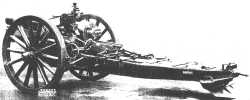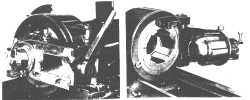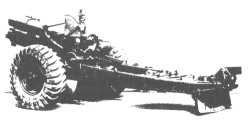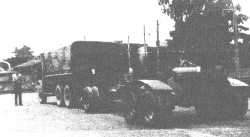|
BL 6-in 26-cwt howitzer | ||||||||||
With the onset of World War 1 the need for a handier and more efficient howitzer than the 6-in 30-cwt soon made itself felt. Designers came up with the BL 6-in 26-cwt equipment, manufacture of which began in 1915. An example is shown in Fig. 1. Fig. 1: BL 6-in 26-cwt Howitzer Mk 1 on Mk 1 Carriage The piece incorporated the latest technology; it was a combination of built-up construction and 'wire' winding, the latter being of steel riband 1/4 x 1/16-inch (6.36 x 1.59-mm) section. Rifling was polygroove plain section (PPS), of uniform twist, one turn in 15 calibres. The breech mechanism consisted of a Welin single-action screw with steep-coned obturator and a vertically acting lever breech mechanism (LBM), which speeded up opening and closing. See Fig. 2. Fig. 2: Breech mechanism for BL 5.5-in gun, which is virtually identical to that fitted to the BL 6-in howitzer.
As with other early BL artillery equipments designed for use in the field, the howitzer was at first fired by 'T' friction tube, a method dating back to smooth-bore days. But tubes were so loose-fitting that the explosion of the propellant charge caused hot gas to leak back through the vent, causung severe erosion. A more efficient vent sealer had to be found. Locks improvised from obsolete Martini-Enfield (ME) rifles were thereupon fitted and proved satisfactory as a temporary measure. They fired 'tubes vent sealing' which were simply .303-in cartridge cases suitably filled, and which effectively sealed the vent. Firing was by withdrawal of a pin by means of a lanyard. In due course ME locks were replaced by 'locks percussion H' (locks PH). A simple mechanism, its principal part was a striker withdrawn then released by a steel wedge attached to the firing lanyard. In turn it was replaced by 'lock PK' , more complicated but more easily operated. The changes to the firing system were the sole modifications made to the howitzer throughout its life, so satisfactory was its overall performance. By the end of World War 1, 3633 howitzers had been made, not only for the British Army but also for allies and colonies including New Zealand. During the conflict the howitzer proved a thoroughly reliable piece, and consumed no fewer than 22,400,000 rounds of ammunition on the Western Front alone. Mechanisation of field and medium artillery equipment commenced in the United Kingdom during the 1920s, but in New Zealand not until June 1938. Fig. 3 shows an example of a 6-in howitzer mechanised by fitting with very large pneumatic-tyred wheels for use by the Royal Artillery.
On the other hand the New Zealand Government adopted a local pattern conversion kit devised by the Public Works Department. It consisted of a bogie built up from four pairs of heavy truck wheels. The latter were designed to be turned inwards after the gun came into action, supposedly to make handling easier, but were of little help in this respect. The bogie was over-complicated, made the trail more difficult to traverse than with the old wooden wheels, and did not 'track' well behind the towing vehicle - as the trail of smashed one-way bridges in certain parts amply testified! See Fig. 4.
* The hydro-pneumatic recoil system proved so efficient and reliable that it was used on the BL 4.5-in and 5.5-in guns over 20 years later. The howitzer remained on active service until 1941 and was declared obsolete in the UK in 1945. However, during its final years rifling became stripped in one or two, probably through metal fatigue. Despite these failures the New Zealand Army retained the howitzers for CMT (Compulsory Military Training) until a premature occurred around 1953 with extensive damage to the muzzle of the piece concerned. Luckily no one was injured, but the howitzers were quickly retired. Two of them may be seen in the Arrny Memorial Museum, Waiouru. Having seen the damaged howitzer at the RNZEME Workshops while on a tour of duty to Burnham Camp, the writer prevailed upon the OC, the late Captain WC Hastings RNZEME, to saw off the muzzle and send it to the School of Artillery. There it proved useful for explaining details of gun construction, including wire winding. Unfortunately later staff consigned it to the scrap heap.
WL Ruffell
Guns at Waiouru | Guns around New Zealand | More equipments | Home |




